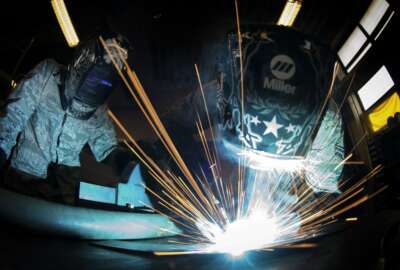
Forthcoming Army plan seeks to ‘transform’ organic industrial base
Billions have been spent to overhaul the Army's aging weapons plants, but officials say the system needs a fundamental rethinking to make it agile enough to kee...
The 16 Army-owned weapons depots that produce all of the military’s conventional munitions and dispose of aging and banned weapons are, on average, 58 years old.
And even though the Army has spent more than $3 billion over the last decade trying to bring the facilities to modern standards, officials have concluded they need a new approach: “Transformation” rather than mere modernization.
The Army is now drafting an updated 15-year plan for its organic industrial base. Among the objectives is to make the facilities safer after a string of three fatal accidents in the past six years. But leaders say the facilities also need to be overhauled or replaced to meet emerging military needs. More than half date back to the World War II-era, and were built with a single purpose in mind.
“A building was designed to support a process for artillery shells, and it wasn’t designed with anything else in mind,” Brig. Gen. Vincent Malone, the joint program executive officer for armaments and ammunition told reporters Tuesday. “Going forward, we have to design for flexible execution and that’s more feasible today because our machinery, by and large, is being designed for flexible execution. So we’ll build our buildings with modularity in mind, and also expansion. If surge capacity drives us to need additional space, we have to think through that and how we might expand a given line to support that.”
Improving worker safety is also a major consideration in the 15-year plan.
In 2018, Andrew Goad, 42, died in a propellant fire while he was working on a production line at Radford Army Ammunition Plant in southwestern Virginia. A year earlier, an explosion killed Lawrence Bass, 55, a worker at Lake City Army Ammunition Plant near Kansas City. And in 2014 Troy Snaadt, 31, died in an accident while he operating an excavator at the Iowa Army Ammunition Plant.
Dr. Bruce Jette, the assistant secretary of the Army for acquisition, logistics and technology said one key objective of the organic industrial base redesign would be to keep employees physically separated from the most dangerous aspects of building munitions, including by implementing more robotics on production lines.
“We need to get the people away from the energetics, and to that effect, we need to begin implementing technology and the architectures that allow us to implement a modular technology, an evolvable technology,” he said. “That’s transformational. You can’t do that with the current design for the facilities – it’s not just an upgrade to the current facilities. That’s one reason why we we’ve begun this effort to get the Office of the Secretary of Defense and Congress in line with us, to help us make sure that there are no roadblocks to moving down that path.”
At the same time, Jette said the Army is using its reassessment of the organic industrial base to ask new questions about the soundness of its supply chain.
For example, the U.S. military buys nearly all of its supply of dinitroanisole (DNAN), a critical component in artillery shells and other munitions, from overseas. Jette said the main motivator for those purchasing decisions has been cost, but it may prove unwise for the military to be completely dependent on foreign sources for a must-have ingredient.
“I can get cheap DNAN from overseas, or I can get it for twice the price if I want to go through a process that’s going to cost me quite a bit to build the facility,” he said, adding that the higher cost was due partly to strict U.S. environmental regulations. “What that does is it drives my ammo costs up, that’s part of why we want to Congress’s participation in this, because it has an impact on the ammo budget.”
Copyright © 2024 Federal News Network. All rights reserved. This website is not intended for users located within the European Economic Area.
Jared Serbu is deputy editor of Federal News Network and reports on the Defense Department’s contracting, legislative, workforce and IT issues.
Follow @jserbuWFED
Related Stories





